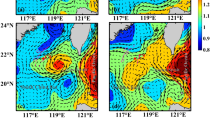Abstract
The seasonal variation of mixing layer depth (MLD) in the ocean is determined by a wind stress and a buoyance flux. A South China Sea (SCS) ocean data assimilation system is used to analyze the seasonal cycle of its MLD. It is found that the variability of MLD in the SCS is shallow in summer and deep in winter, as is the case in general. Owing to local atmosphere forcing and ocean dynamics, the seasonal variability shows a regional characteristic in the SCS. In the northern SCS, the MLD is shallow in summer and deep in winter, affected coherently by the wind stress and the buoyance flux. The variation of MLD in the west is close to that in the central SCS, influenced by the advection of strong western boundary currents. The eastern SCS presents an annual cycle, which is deep in summer and shallow in winter, primarily impacted by a heat flux on the air-sea interface. So regional characteristic needs to be cared in the analysis about the MLD of SCS.
Similar content being viewed by others
References
Du Yan, Wang Dongxiao, Chen Ju, et al. 2004. The character of abnormal salinity body of water in the bottom of mixing layer of South China Sea. Journal of Tropical Oceanography (in Chinese), 23(6): 52–59
Du Yan, Wang Dongxiao, Zhou Weidong, et al. 2004. Intercomparison of three South China Sea circulation models. Acta Oceanologica Sinica, 23(1): 41–50
Fang Wendong, Fang Guohong, Shi Ping, et al. 2002. Seasonal structures of upper layer circulation in the southern South China Sea from in situ observations. J Geophys Res, 107: C113202, doi: 10.1029/2002JC001343
Gan Jianping, Li H, Curchitsert E N, et al. 2006. Modeling South China Sea circulation: Response to seasonal forcing regimes. J Geophys Res, 111: C06034, doi: 10.1029/2005JC003298
Garratt J R. 1977. Review of drag coefficients over oceans and continents. Mon Wea Rev, 105: 915–929
Halkides D, Lee T. 2008. Mechanisms controlling seasonal-to-interannual mixed-layer temperature variability in the southeastern tropical Indian Ocean. J Geophys Res, 114: C02012, doi: 10.1029/2008JC004949
Ho Chungru, Kuo Nanjung, Zheng quanan, et al. 2000. Dynamically active areas in the South China Sea detected from TOPEX/POSEIDON satellite altimeter data. Remote Sena Environ, 71: 320–328
Jerlov N G. 1968. Optical Oceanography. Amsterdam: Elsevier Publishing Company, 194
Kim S B, Lee T, Fukumori I. 2007. Mechanisms controlling the interannual variation of mixed layer temperature averaged over the Niño-3 region. J Clim, 20: 3822–3843, doi: http://dx.doi.org/10.1175/JCLI4206.1
Liu Qinyu, Wang Dongxiao, Jia Yinglai, et al. 2002. Seasonal variation and Formation mechanism of the South China Sea warm water. Acta Oceanologica Sinica, 21(3): 331–343
Liu Qinyu, Xia Jiang, Xie Shangping, et al. 2004. A gap in the Indo-Pacific warm pool over the South China Sea in boreal winter: Seasonal development and interannual variability. J Geophys Res, 109: C07012, doi: 10.1029/2003JC002179
Lu Juzhong, Lin Chunyu. 1987. The relationship between drought and flood in the Meiyu period and the monsoon in the summer and winter of East Asia. Meteorological Science and Technology (in Chinese), 11: 77–82
Pan Aijun, Wan Xiaofang, Xu Jingdian, et al. 2006. The character and formation mechanism of barrier layer in the North-east of South China Sea. Chinese Science Bulletin (in Chinese), 51(8): 951–957
Paulson C A, Simpson J. 1977. Irradiance measurement the upper ocean. J Phys Oceanogr, 7: 952–956
Qu Tangdong. 2001. Role of ocean dynamics in determining the mean seasonal cycle of the South China Sea surface temperature. J Geophys Res, 106: 6943–6955
Qu Tangdong, Du Yan, Gan Jianping, et al. 2007. Mean seasonal cycle of isothermal depth in the South China Sea. J Geophys Res, 112: doi: 10.1029/2006JC003583
Shi Ping, Du Yan, Wang Dongxiao, et al. 2001. The annual cycle feature of mixing layer in the South China Sea. Journal of Tropical Oceanography (in Chinese), 20(1): 10–17
Uppala S M, Kallberg P W, Simmons A J, et al. 2005. The ERA-40 reanalysis. Quart J R Meteorol Soc, 131: 2961–3012, doi: 10.1256/qj.04.176
Wang Dongxiao, Zhou Faxiu, Li Yongping. 1997. The annual cycle feature of sea surface temperature and heat budget in South China Sea. Acta Oceanologica Sinica (in Chinese), 19(3): 33–44
Xiao Xianjun, Wang Dongxiao, Xu Jianjun. 2006. The assimilation experiment in the southwestern South China Sea in summer 2000. Chinese Sci Bul, 51: 31–37
Xiao Xianjun, Wang Dongxiao, YAN Changxiang, et al. 2008. Evaluation of a 3dVAR system for the South China Sea. Prog Nat Sci, 8: 547–554
Xu Haiming, Xie Shangping, WANG Yuqing, et al. 2008. Orographic effects on South China Sea summer climate. Meteorol Atmos Phys, 100: 275–289, doi: 10.1007/s00703-008-0309-4
Yang Haijun, Liu Qinyu, Jia Xujing. 1999. On the upper oceanic heat budget in the South China Sea: annual cycle. Advances in Atmospheric Sciences, 10(4): 619–629
Zeng Lili, Du Yan, Xie Shangping, et al. 2009. Barrier layer in the South China Sea during summer 2000. Dynamics of Atmospheres and Oceans, 47: doi: 10.1016/j.dynatmoce.2008.08.001
Zhu Qiangeng. 1990. The winter monsoon research of East Asia in China. Meteorlogical Monthly (in Chinese), 16(1): 3–10
Zhuang Wei, Xie Shangping, Wang Dongxiao, et al. 2010. Intraseasonal variability in sea surface height over the South China Sea. J Geophys Res, 115: C04010, doi: 10.1029/2009JC005647
Author information
Authors and Affiliations
Corresponding author
Additional information
Foundation item: The National Basic Research Program of China under contract Nos 2011CB403505 and 2011CB403504; the National Natural Science Foundation of China under contract No. 41206007; the City University of Hong Kong Stritegic Research Grants under contract Nos 7002917 and 7002780; the Knowledge Innovation Project for Distinguished Young Scholar of The Chinese Academy of Sciences under contract KZCX2-EWQN203; the foundation for operational development of the National Marine Environment Forecasting Center under contract No. 2013006.
Rights and permissions
About this article
Cite this article
Xiao, X., Wang, D., Zhou, W. et al. Impacts of a wind stress and a buoyancy flux on the seasonal variation of mixing layer depth in the South China Sea. Acta Oceanol. Sin. 32, 30–37 (2013). https://doi.org/10.1007/s13131-013-0349-6
Received:
Accepted:
Published:
Issue Date:
DOI: https://doi.org/10.1007/s13131-013-0349-6




